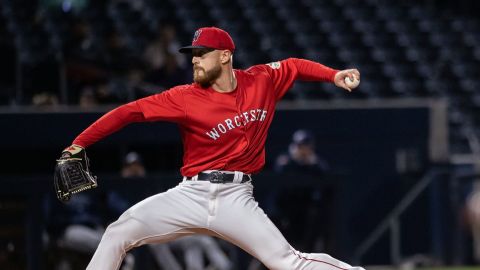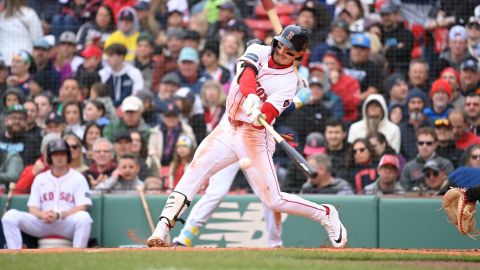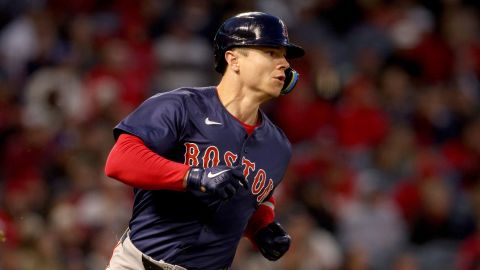Give the Boston Red Sox credit. They’ve been shoveling.
The Red Sox fell into a hole in the first half, plummeting to as many as 10 1/2 games back in the American League East on June 20. Boston has begun to dig its way out of the hole, however, as the Red Sox sit 6 1/2 games back of the division-leading New York Yankees with 73 games remaining on their schedule after the Major League Baseball All-Star break.
But does the Red Sox’s recent turnaround represent progress or is it simply creating false hope? The questions dropped in this week’s mailbag suggest opinions vary across the fan base.
Many questions, of course, focused on specific midseason issues facing the Red Sox, so let’s stop wasting time and address what’s on your mind as Boston prepares for the second half.
What are the Red Sox going to do about Mike Napoli?
— Little Vivian
Ideally, Napoli would use his apparent personal vendetta against the Los Angeles Angels as a springboard toward a good second half. The Red Sox play four games against the Halos starting Friday.
It’s time to start thinking about life after Napoli, though, because even if he sticks around this season, it’s hard to imagine him returning in free agency over the offseason based on his 2015 performance. The first week or so out of the break could dictate whether Napoli even finishes the year with Boston.
The Red Sox have received virtually zero production from first base this season — only the Tampa Bay Rays have a worse average and OPS from the position — and Dustin Pedroia’s return creates a roster crunch, as Boston will need to find new ways to insert Brock Holt into the lineup. If Napoli doesn’t improve soon, the Red Sox could cut ties and/or deploy Holt at first base more frequently.
But not only does Holt not fit the mold of a traditional first baseman. He’s also most valuable to the Red Sox when he’s bouncing around the diamond. The problem is Boston doesn’t have an internal first base option that jumps off the page. Travis Shaw could become a nice player someday, but he’s an unknown quantity. Allen Craig isn’t exactly tearing up Triple-A. And there’s no way the David Ortiz experiment will become a regular thing, as there are too many variables at play, including Big Papi’s willingness.
The Red Sox could look for outside help, but the trade market is relatively thin. Carlos Santana, the switch-hitting catcher-turned-first baseman of the Cleveland Indians, is intriguing, but the Tribe probably have little desire to deal him given his team-friendly contract. Adam Lind of the Milwaukee Brewers, Adam LaRoche of the Chicago White Sox and Mitch Moreland of the Texas Rangers all seem like logical trade candidates given their respective teams’ place in the standings, but all are left-handed hitters and the Red Sox might not want to risk reliving their early-season issues against southpaws.
Perhaps the Red Sox should try Pablo Sandoval at first base to see if that could be a legitimate long-term fix. He certainly fits the bill more than Holt. And while Hanley Ramirez’s name has been tossed around in speculation regarding first base, the idea of him transitioning to a new position in the middle of the season and learning the idiosyncrasies — however small they might be — of first base is cringe-inducing.
Maybe Napoli will turn things around. Maybe Craig will show life by the time Napoli’s clock runs out (if it does). Or maybe a trade candidate controllable through 2016 will appease the Red Sox. Clearly, it’s a unique situation that’s going to require Boston to think outside the box before settling on a decision.
Napoli is having a horrible season in his walk year. How about the Red Sox talk to the Phillies about packaging Cole Hamels and Ryan Howard, with Boston taking on both salaries but giving up lesser prospects in exchange for taking Howard off their books. Who knows? Maybe Howard finds the change of scenery to his liking.
— Mike Gauthier
I like the creativity. I also don’t hate the idea of finding a way to relinquish lesser talent in exchange for assuming a heavier financial burden, as it’s seemingly conducive to the advantages that come with being a big market team, like the Red Sox. However, I’m a bit skeptical of your proposal.
This trade obviously would be about landing Hamels. Although Napoli is having a terrible year, Howard is in no way, shape or form an upgrade at first base. In fact, Napoli and Howard entered the All-Star break with matching -0.2 WAR marks. Cute, I know.
Since we don’t know how much of Howard’s contract the Red Sox would be willing to absorb in such a trade, let’s use your idea of taking on the whole thing in addition to the money owed to Hamels.
Howard is owed at least $35 million beyond this season. He’s attached to a $25 million salary for 2016, and his contract includes a $23 million club option for 2017. Unless Ben Cherington starts smoking crack over the next 15 months, which I highly doubt, there’s no way the Red Sox would exercise that 2017 option, meaning they’d instead opt for the $10 million buyout in Howard’s deal.
Hamels’ contract comes with even more caveats. At minimum, he’s owed $73.5 million beyond this season, but the more likely figure is $87.5 million. We arrive at that number by considering his $22.5 million salary each season from 2016 through 2018 ($67.5 million total) and the $20 million option for 2019 the Red Sox likely would be required to exercise in order for the left-hander to agree to waive his no-trade clause.
The bill for Hamels could climb another $4 million to $91.5 million total if his 2019 option instead vests. (According to Cot’s Contracts, Hamels’ option for 2019 is guaranteed at $24 million if 1) he has 400 innings pitched in 2017-18, including 200 innings in 2018, and 2) he is not on the disabled list with a shoulder or elbow injury at the end of the 2018 season.)
If you add the expenditures, the Red Sox would be on the hook for $108.5 million at bare minimum. More likely, they’d be required to pay — again, assuming they took on Howard’s entire contract — $122.5 million ($35 million for Howard and $87.5 million for Hamels) from 2016 through 2019. Since Howard is unlikely to provide positive production, the Red Sox essentially would be paying that amount for four years of Hamels. And at more than $30 million annually, that represents an overpay, especially since we haven’t even taken into account the money owed to each player for the remainder of this season or the pieces Boston would need to surrender in addition to assuming all of that cold, hard cash.
Hamels is an attractive option in large because his contract, on its own, is reasonable for a pitcher of his caliber. There still is the great unknown of him pitching in the American League, though, as well as the regression he might soon show by virtue of already having more than 1,900 regular-season innings on his arm. When you start adding to the financial burden and factoring in the prospects, albeit lower-tier, you’d still need to give up to acquire his services, the 31-year-old (who turns 32 in December) becomes far less attractive.
At some point, one must remove the name from the equation and determine whether it’s really worth jumping through so many hoops for “Player A.” I’d say “no” in the scenario you laid out.
Do you foresee the Red Sox making any trades?
— Rich Cerasale
Yes, I could envision the Red Sox making a splash. But whatever they do must be with an eye toward the future. No rentals. This team hasn’t shown enough for the front office to commit to going all-in for 2015. There’s no sense in the Red Sox setting themselves back for little to no gain this season.
The Red Sox are going to need to stabilize both their rotation and their bullpen over the offseason regardless of how this season plays out. If they can obtain pieces that’ll expedite that process in addition to providing a boost in their quest to contend this season, then they absolute should pull the trigger.
The Red Sox aren’t quite buyers and they’re not quite sellers. It’s a strange identity crisis many middle-of-the-pack teams now face each season with the addition of a second wild card spot.
Is there anyone in the Red Sox’s bullpen besides Koji Uehara and Junichi Tazawa who can get batters out?
— Tom Widell
The Red Sox’s inability to build a strong bullpen was a huge offseason flub, especially with there being so many questions in their rotation. It was an obvious possibility Boston’s ‘pen would be taxed — as it has been — and the Red Sox did little to prepare themselves for such a scenario. Uehara and Tazawa have been about as good as Boston could have expected, yet the relief corps remains uninspiring.
A good bullpen a lot of times comes from within, so it’s hard to justify committing too many resources to building the unit. There’s so much fluctuation across baseball annually as it relates to relievers. But it’s clearly a weakness of this team and one that must be addressed, either this season or over the winter.
In fact, the bullpen might be the single biggest difference between the last-place Red Sox and the first-place Yankees. The Houston Astros also have benefited from offseason additions to their bullpen.
When Alexi Ogando (a reclamation project) and Tommy Layne (a San Diego Padres castoff) are your two most trusted relievers beyond Uehara (40 years old) and Tazawa, it’s not the best look. And that’s not a knock on Ogando or Layne, who both did serviceable jobs earlier this season.
Things have been bad for the Red Sox, but they’re now showing fight. Can they be this year’s version of the 2013 Los Angeles Dodgers?
— Mike Sullivan
I wouldn’t count on a turnaround of those proportions.
The Dodgers started slow in 2013 before rallying to win the National League West, but they were .500 (47-47) and 2 1/2 games back in the division at the All-Star break.
More importantly, the Dodgers were led by two of the best pitchers on the planet in Clayton Kershaw and Zack Greinke. The rest of that team was pretty damn good, too.
What is the probability of the Red Sox making the playoffs?
— Tony Shackford
According to the fine folks over at FanGraphs, who are way smarter than I’ll ever be, the Red Sox open the second half with a 23.2 percent chance of winning the division or earning a wild card spot. They have a 2.5 percent chance of winning the World Series, for what it’s worth.
If you’re asking in less specific terms whether the Red Sox are likely to contend in the second half, I’d advise you to proceed with the most cautious of optimism.
Yes, they’ve played better. Yes, they’ve shown more life. And yes, the AL East toes the line of mediocrity. But the bigger picture suggests the Red Sox still have flaws that could be exposed over the long haul.
Either way, I’m ready for the second half. You?
Thumbnail photo via Brad Rempel/USA TODAY Sports Images




